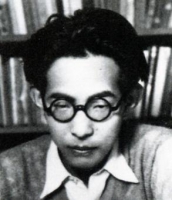| Hori Tatsuo | |
| 出生地: | 日本东京都 |
| | |
堀辰雄(1904年12月28日~1953年5月28日)是一位在昭和初期活跃的日本作家,出生于日本东京都。他是日本大正时代短篇小说大师芥川龙之介唯一的弟子。
经历
堀辰雄从府立三中到第一高级中学就读。与同时入学的神西清相识,并成为终身的朋友。同时,与正在高中就读的室生犀星和芥川龙之介的相识。此外,在关东大地震时失去母亲的经验,可以说影响了他此后的文学风格。
就读东京帝国大学文学系国文科后,与中野重治和洼川鹤次郎相识,也受到小林秀雄和永井龙男的同人志影响,无产阶级文学派和所谓的艺术派,及代表昭和文学的流派的双方的联结。因为受到这两者的影响,堀辰雄的作品有着独特的情境。
1925年(大正14年)夏天,堀辰雄搬到轻井泽,在当地住了两个月。他因而认识芥川龙之介和室生犀星、戏剧翻译家片山广子。芥川龙之介自杀后,堀辰雄深受打击,后来并参与芥川龙之介全集的编辑。1929年他从东京帝国大学毕业,毕业论文写是“芥川龙之介论”。
1926年与中野重治创刊同人志‘驴马’。这个时期,也包含了受到‘水族馆’等现代主义强烈影响的作品。1927年,他得了肋膜炎,差一点死去。这一年他办理休学,四月时住到汤河原、八月改到轻井泽静养,因此以那里做为舞台的作品相当多。1930年十一月,《神圣家族》初次在文坛发表。1931年四月到六月住进长野县富士见的高原疗养院。
在轻井泽疗养同时,他接触了马塞尔·普鲁斯特和詹姆斯·乔伊斯、斯汤达尔、普罗斯佩·梅里美等当时的欧洲文学,加深了他的作品的深度。对于后期的作品‘幼年时代’(1938年-1939年)时被认为是过去的回忆,许多人看到了普鲁斯特的影响。1934年堀辰雄开始以《菜穗子》为题,构想新小说,刚开始并不顺利。但这个故事历经数年,一直在他内心发酵。当时他和执笔《美丽村庄》时认识的矢野绫子订婚。翌年七月,矢野绫子因为肺结核症状恶化,堀辰雄自己健康也不佳,两人一起住进富士见的高原疗养院。矢野绫子于当年年底去世。
1936年秋天,堀辰雄开始执笔以绫子的“爱”与“死”为主题的《风起》。第二年该短篇由新潮社出版。之后堀辰雄历经数次的乡居疗养,并和加藤多惠子结婚,婚后定居轻井泽。构思多年的《菜穗子》也终于完稿由创元社出版。1942年《菜穗子》获得第一届中央公论社文艺赏。
1953年,堀辰雄去世,享年49岁。川端康成担任葬仪委员会会长。
作品
- 《聖家族》(1930年)
- 《美しい村》(1933年)
- 《风吹了》(風立ちぬ)(1936-37年)
- 《かげろふの日記》(1937年)
- 《曠野》(1941年)
- 《菜穗子》(1941年)
- 《大和路・信濃路》(1943年)
参考文献
Tatsuo Hori (堀 辰雄, Hori Tatsuo, 28 December 1904 – 28 May 1953) was a writer, poet, and translator in Shōwa period Japan.
Early life
Hori was born in Tokyo, and was a graduate of Tokyo Imperial University. While still a student, he contributed translations of modern French poets to a literary journal called Roba, which was sponsored by poet Murō Saisei. He regarded himself as a disciple of Ryūnosuke Akutagawa, but his early works exhibit an attraction to the proletarian literary movement as viewed by his friends Nagai Tatsuo and Kobayashi Hideo. His later works reflect a movement towards modernism.
Literary career
Hori wrote a number of novelettes and poems, which are set in atmospheric locations, such as a mountain sanatorium in Nagano Prefecture, and are characterized by the melancholic theme of death, which reflect his own ongoing battle with tuberculosis. Often plotless and impressionistic, his style was praised by Kawabata Yasunari.
Hori wrote Yamatoji, a small sentimental collection of poetic essays about Nara and its historic sites. This was followed by Adashino, a tragic romance set in the Nara period. His beautiful descriptions of Nara and the world of the ancient capital have been popularized by the tourist authorities in that city. The town of Karuizawa, Nagano prefecture, where Hori stayed during his illness, established the Hori Tatsuo Memorial Museum in his honor. His grave is at Tama Reien, a cemetery in the outskirts of Tokyo.
Major works
- Sei Kazoku (The Holy Family (聖家族), 1932)
- Utsukushii Mura (Beautiful Village (美しい村), 1933)
- Kaze Tachinu (The Wind Has Risen (風立ちぬ), 1936–37)
- Kagerou no Nikki (Diary of Mayfly (かげろふの日記), 1937)
- Naoko (Naoko (菜穂子), 1941)
- Arano (Arano (曠野), 1941)
- Younen Jidai (Childhood (幼年時代), 1942)

